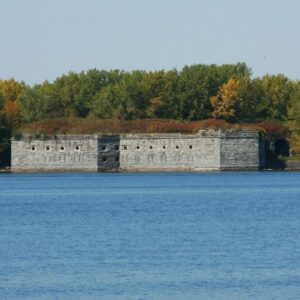We all make mistakes. To err is human, after all. For example, fences are sometimes built on the wrong side of the property line. It happens.
When armies and nations make such a faux pas, war can result. Fortunately, that didn’t happen with this tale. Though the story does begin with a war. Two of them, in fact.
We know Canada today as a mellow place, a country famous for its politeness and good manners (along with an odd affinity for fries topped with cheese curds and hot gravy). But that wasn’t always the case.
When the American colonies launched the Revolutionary War, our neighbor to the north stayed loyal to England. Twice (during the Revolution and again 37 years later in its sequel, the War of 1812), the U.S. invaded Canada. And twice, America retreated in defeat.
After narrowly surviving the War of 1812, President James Madison decided it was time to seriously invest in defense spending. Since a fort had famously stopped the British fleet at Baltimore (giving us “The Star-Spangled Banner” in the process), the War Department set about building a string of fortifications along the Atlantic coast, many of which still stand today.
An imposing fort was planned to protect America from Canada as well. Money was authorized to build an 8-sided fortification with 30-foot stone walls and armed with 125 powerful cannons. It would be built in New York on the northern end of Lake Champlain within sight of the border with Canada. Twice during both wars, the British had used that waterway to launch invasions of our country. When the new fort was in place, no warship could get past it.
So, the Army set to work building the new fortress in 1816. Dozens of civilian workmen and soldiers, overseen by the Corps of Engineers, commenced the mighty task. It was so important that President James Madison even inspected the site in 1817. Things were progressing nicely. Dozens of acres of woodland had been cleared, and the massive stone walls were going up.
Then it happened. A clerk in Washington discovered a mistake. A bad mistake. A make-your-face-turn-red and hang-your-head-in-shame mistake.
The survey that had been used to select the new fort’s site was wrong. Way wrong. It mistakenly placed the international border three-quarters of a mile to the south. Meaning the fort intended to protect us from Canada was being built—in Canada!
Madison was mortified. He ordered construction to stop, told the Army to immediately withdraw, and then apologized profusely to the Canadians, who shrugged it off with a neighborly “these things happen” response.
Washington had spent $175,000 (about $4 million today) on the project. Now, it was all wasted in a textbook example of a government boondoggle.
With the Army gone, local residents took stone and other materials to use in their houses, buildings, and barns. In a few years, the site was picked clean. No trace of it now exists.
The fort had never been given a name. Americans and Canadians alike eventually called the place exactly what it was: Fort Blunder.
Twenty years later, the Army built another fortification nearby. Fort Montgomery was smaller and less imposing than the original design. By then, U.S.-Canadian relations were warming significantly. In 1909, it was abandoned. Today, it sits empty on the shores of Lake Champlain, a decaying relic from a bygone era.
But one thing was certain: When the Army began building Fort Montgomery, you can bet they made darn sure they went to work on the right side of the border.


